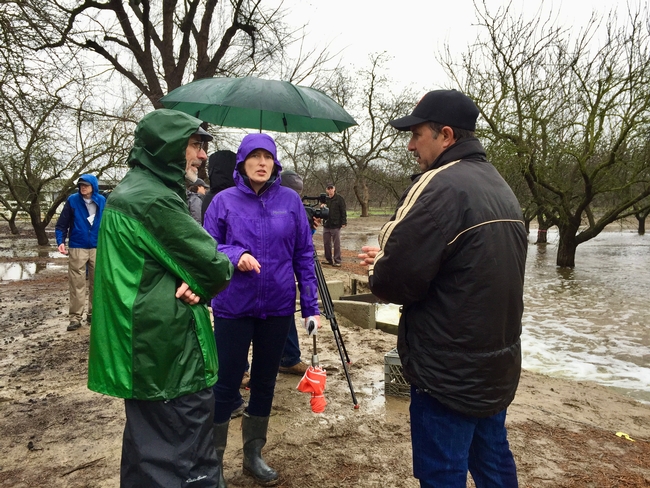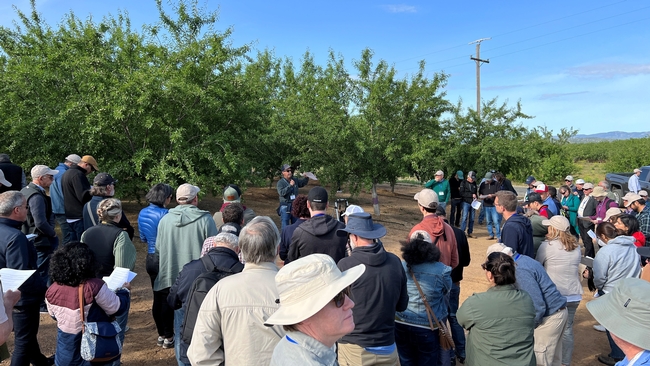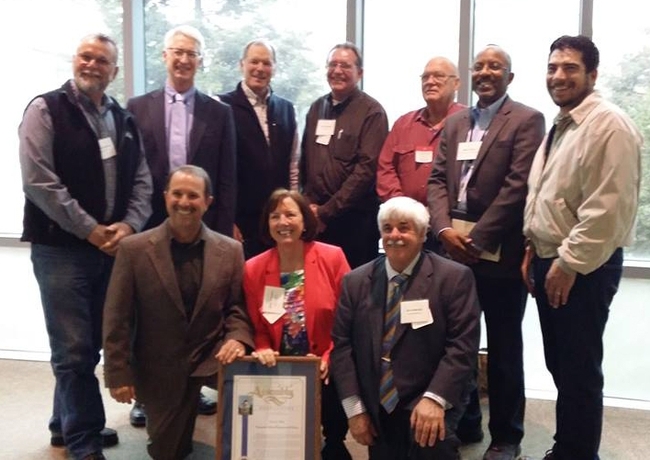Posts Tagged: Roger Duncan
Duncan’s research ‘blew up preconceived ideas,’ improved almond, peach, grape production
Roger Duncan, UCCE farm advisor in Stanislaus County, retires after 36 years
For more than three decades, tree fruit and nut growers have depended on the advice of Roger Duncan, UC Cooperative Extension pomology farm advisor in Stanislaus County, to improve their production practices. Duncan, whose research and extension program focused on almonds, peaches, grapes and other tree crops, retired July 1.
“Roger Duncan has been an extraordinarily relevant researcher for the predominant crops in Stanislaus County,” said Rep. John Duarte, owner of Duarte Nursery in Hughson. “His research has encompassed rootstock and variety selection, tree spacing, chemical inputs and spraying, fertilizers, pruning and replanting amongst other projects.”
Duncan began working for UC ANR in 1988 as a field assistant to Integrated Pest Management advisor Jim Stapleton after earning a master's degree in plant science and plant pathology from Fresno State and a bachelor's degree in the same subjects from UC Davis. In 1990, he became a UC Cooperative Extension in pomology farm advisor in Stanislaus County.
During Duncan's tenure, the planted acreage of tree and vine crops has tripled in Stanislaus County to nearly 1,900 farms on over 230,000 acres. His research has helped to improve production efficiency through improved rootstocks, crop varieties and production practices.
“Roger provides growers with resources and tools on nutrition, sprays, nutrient deficiencies, calendars, costs, pest management and other horticultural practices,” Duarte said. “His work has had significant impact on the productivity and quality of almonds, peaches and grapes. Breeders, universities, nurseries, growers and marketers have all gained from the wisdom and dedication of Roger Duncan.”
Growing up in Modesto, Duncan wasn't raised on a farm. “I had friends whose families farmed orchard crops, so I had some exposure,” he said. “I caught the Extension bug while working as a summer intern for the pomology advisors in the Stanislaus County UCCE office after I graduated with my B.S. That is what inspired me to return to school with the goal of being a pomology farm advisor.”
Reducing production costs
To help growers lower production costs, Duncan introduced orchard practices aimed at reducing hand labor and other inputs. As a result of his research, minimal pruning has become the norm in California almond production, reducing input costs and carbon output and increasing yield. He also improved monitoring and management techniques of established and invasive diseases and insect pests.
“The practical applications Roger brings to the grower community are invaluable,” said Mel Machado, Blue Diamond Almonds vice president for member relations and Stanislaus County almond grower. “His minimal pruning study stood growers on their heads. People had preconceived ideas about pruning. He blew that up. His research showed that after you get the tree's frame, all you need to remove are the dead and occluded branches. With the market depressed, we needed to cut costs. He said, ‘You don't need pruning.' Now I'm growing bushes.”
Art Bowman, a crop adviser with Salida Ag Chem, agreed that Duncan's pruning research had an impact. “Roger's pruning trial that lasted over 20 years was a much-discussed subject among growers,” Bowman said. “Growers' pruning practices definitely changed due to Roger's research, with early emphasis on structural development and, later in the tree's life, concentrating on tree accessibility and deadwood removal.”
In 1990, when Duncan joined UC Cooperative Extension, California had 408,700 acres of almonds, according to the California Agricultural Statistics Service. Now the state has over 1.5 million acres of almonds.
About 75% of the farms Duncan has served have 40 acres or less, farmed by “small” or “part-time” farmers, who needed to learn basic horticulture and pest management. Stanislaus County also is home to some very large, sophisticated growers, who Duncan has kept apprised of new technology.
“I believe that personal interaction offers the most memorable means of information transfer, which is why I held an average of 12-plus extension events per year, gave 18-plus extension presentations per year, and went on an average of over 75 individual farm calls per year,” Duncan said. He also provided information via videos, blogs, podcasts, radio shows, newsletters, news media and extension publications as well as commodity boards.
Along with Duncan's research, Bowman has appreciated his availability. “Roger was always ready to take a call, make orchard visits and listen to a grower's concern or problem,” he said.
In 1997, Duncan began hosting twice monthly Tree & Vine Integrated Pest Management breakfast meetings for pest control advisers and growers to discuss current and potential pest threats. These meetings have continued for 28 years.
He speaks ‘farmer'
Machado attributes much of Duncan's success to his communication skills. “His research is scientific and he speaks ‘farmer,'” he said.
Machado gave rootstock as an example. “Roger is my rootstock resource; he knows rootstocks better than anybody,” he said. “His rootstock trial is dirt simple. There's a different rootstock every five trees. You can see walking down the row the differences in the rootstocks.”
From his field evaluations, Duncan identified a complex hybrid rootstock that is highly tolerant to ring nematode, bacterial canker and salt toxicity. He found other hybrid rootstocks that boost crop yield while reducing risk from soil chemistry and soil-borne disease challenges, enabling almonds to be grown in the marginal soils on the west side of the North San Joaquin Valley. To help growers choose the appropriate rootstock for their soil, he wrote a comprehensive ANR publication, made a video and worked with the UC Fruit & Nut Center to create an interactive rootstock comparison website.
Over the last 15 years, use of hybrid almond rootstocks has increased dramatically. Burchell Nursery now sells approximately 40% of their trees on hybrid rootstock compared to less than 5% of almond trees 15 years ago, and more than 95% of Duarte Nursery almond trees are on hybrid rootstocks, according to Duncan.
“We've worked with Roger for years, back when he didn't have a mustache and then when he had a mustache,” said Robert Longstreth, who grows almonds, walnuts and cherries.
“Roger does research in the area you need, not frivolous stuff that you don't need,” said Longstreth, who has benefited from Duncan's research on pruning, rootstocks, irrigation timing, plant nutrition and disease control. “He's thought very highly of by almond growers. When he has something to say, people listen.”
The UCCE farm advisor has overseen long-term trials to learn how to design and maintain an almond orchard to capture early production, maintain long-term yields and maximize profits. “In the first 17 years of the orchard design project, I increased cumulative net profits by up to $14,000 per acre, including increased yield while reducing labor and carbon inputs,” Duncan said.
Influenced by Duncan's tree-spacing research results, growers have increased almond tree density by 20% per acre statewide, leading to higher crop yields, longer-living orchards and better farm economic sustainability.
As California's expert on almond rootstocks and almond orchard design, Duncan has taught the subjects for the UC Almond Production Short Course, was lead author on the UCANR publication “Almond Rootstocks,” wrote the rootstock chapter, and co-authored the orchard design chapter of the UC Almond Production Manual. He was invited to Chile, Spain and Australia to share his expertise with growers there.
Expanded programs for kids and gardeners
In addition to being a farm advisor, Duncan served as director of UC Cooperative Extension in Stanislaus County from 2011 through 2013 and again from 2017 through 2020. As the UCCE county director, he acquired new county funding to hire a 4-H youth development program representative in 2018 to provide more learning opportunities for local, underrepresented children.
That year, he also acquired county funding to hire a full-time Master Gardener coordinator and launched the first UC Master Gardener Program in the county.
“I felt very lucky to serve as an advisor in the same county where I was born and raised,” Duncan said. “I am most proud of the trust I have developed with the growers and other clientele.”
Professional awards
Recently, Duncan's peers at UC ANR honored him with a Distinguished Service Award for his outstanding extension program, which gave growers the data and confidence to adopt orchard practices that have bumped up the productivity and economic value of California almond orchards.
The popular breakfast meetings to discuss pest management earned Duncan and his UC Cooperative Extension farm advisor colleagues the Entomological Society Award of Extension Excellence and the California Department of Pesticide Regulation's IPM Innovator Award. The California Legislature also recognized the breakfast club's commitment to sustainable pest management.
Recognizing Duncan's extraordinary contributions, the university recently granted him emeritus status.
“I have a lot of respect for the other farm advisors, but Roger is at the top of the pile,” said Machado, who has served on Almond Board committees with Duncan and known him since he joined UC Cooperative Extension. “I'm going to miss him. You can absolutely count on him.”
Congressman and nurseryman Duarte added: “While he will be sorely missed by us in his role of pomology advisor for the University of California, we hope that he keeps his interest, and continues to influence the food production industry in the Central Valley.”
Lawn-pocalypse! Surviving Drought
Ah, summer! The season of sunburns, pool parties, and… lawn droughts. If your once lush, green carpet now looks like a crunchy brown doormat, you're not alone. Let's dive into why your yard is staging a dramatic death scene and what you can do to...

Bermuda grass and weeds overtaking drought stressed turf grass.
Climate-Change Resources
University of California UC ANR Green Blog (Climate Change and Other Topics) https://ucanr.edu/blogs/Green/index.cfm?tagname=climate%20change (full index)
Examples:
- Save Trees First: Tips to Keep Them Alive Under Drought https://ucanr.edu/b/~CdD
- Landscaping with Fire Exposure in Mind: https://ucanr.edu/b/~G4D
- Cities in California Inland Areas Must Make Street Tree Changes to adapt to Future Climate https://ucanr.edu/b/~oF7
Drought, Climate Change and California Water Management Ted Grantham, UC Cooperative Extension specialist (23 minutes) https://youtu.be/dlimj75Wn9Q
Climate Variability and Change: Trends and Impacts on CA Agriculture Tapan Pathak, UC Cooperative Extension specialist (24 minutes) https://youtu.be/bIHI0yqqQJc
California Institute for Water Resources (links to blogs, talks, podcasts, water experts, etc.) https://ciwr.ucanr.edu/California_Drought_Expertise/
UC ANR Wildfire Resources (publications, videos, etc.) https://ucanr.edu/News/For_the_media/Press_kits/Wildfire/ (main website)
-UC ANR Fire Resources and Information https://ucanr.edu/sites/fire/ (main website)
-Preparing Home Landscaping https://ucanr.edu/sites/fire/Prepare/Landscaping/
UC ANR Free Publications https://anrcatalog.ucanr.edu/ (main website)
- Benefits of Plants to Humans and Urban Ecosystems: https://anrcatalog.ucanr.edu/pdf/8726.pdf
-Keeping Plants Alive Under Drought and Water Restrictions (English version) https://anrcatalog.ucanr.edu/pdf/8553.pdf
(Spanish version) https://anrcatalog.ucanr.edu/pdf/8628.pdf
- Use of Graywater in Urban Landscapes https://anrcatalog.ucanr.edu/pdf/8536.pdf
- Sustainable Landscaping in California https://anrcatalog.ucanr.edu/pdf/8504.pdf
Other (Non-UC) Climate Change Resources
Urban Forests and Climate Change. Urban forests play an important role in climate change mitigation and adaptation. Active stewardship of a community's forestry assets can strengthen local resilience to climate change while creating more sustainable and desirable places to live. https://www.fs.usda.gov/ccrc/topics/urban-forests
Examining the Viability of Planting Trees to Mitigate Climate Change (plausible at the forest level) https://climate.nasa.gov/news/2927/examining-the-viability-of-planting-trees-to-help-mitigate-climate-change/
Reports and other information resources coordinated under the auspices of the United Nations and produced through the collaboration of thousands of international scientists to provide a clear and up to date view of the current state of scientific knowledge relevant to climate change. United Nations Climate Action
Scientific reports, programs, action movements and events related to climate change. National Center for Atmospheric Research (National Science Foundation)
Find useful reports, program information and other documents resulting from federally funded research and development into the behavior of the atmosphere and related physical, biological and social systems. Search and find climate data from prehistory through to an hour ago in the world's largest climate data archive. (Formerly the "Climatic Data Center") National Centers for Environmental Information (NOAA)
Think tank providing information, analysis, policy and solution development for addressing climate change and energy issues (formerly known as the: "Pew Center on Global Climate Change"). Center for Climate & Energy Solutions (C2ES)
Mapping Resilience: A Blueprint for Thriving in the Face of Climate Disaster. The Climate Adaptation Knowledge Exchange (CAKE) was launched in July 2010 and is managed by EcoAdapt, a non-profit with a singular mission: to create a robust future in the face of climate change by bringing together diverse players to reshape planning and management in response to rapid climate change. https://www.cakex.org/documents/mapping-resilience-blueprint-thriving-face-climate-disaster
Cal-Adapt provides a way to explore peer-reviewed data that portrays how climate change might affect California at the state and local level. We make this data available through downloads, visualizations, and the Cal-Adapt API for your research, outreach, and adaptation planning needs. Cal-Adapt is a collaboration between state agency funding programs, university and private sector researchers https://cal-adapt.org/
Find reports, maps, data and other resources produced through a confederation of the research arms of 13 Federal departments and agencies that carry out research and develop and maintain capabilities that support the Nation's response to global change. Global Change (U.S. Global Change Research Program)
The Pacific Institute is a global water think tank that combines science-based thought leadership with active outreach to influence local, national, and international efforts to develop sustainable water policies. https://pacinst.org/our-approach/
Making equity real in climate adaptation and community resilience policies and programs: a guidebook. https://greenlining.org/publications/2019/making-equity-real-in-climate-adaption-and-community-resilience-policies-and-programs-a-guidebook/
Quarterly CA Climate Updates and CA Drought Monitor Maps (updated each Thursday) https://www.drought.gov/documents/quarterly-climate-impacts-and-outlook-western-region-june-2022
Drought focus of Water Resources IMPACT magazine special issue
UC ANR experts address emotional toll of drought
Preparing the American West for prolonged drought is the focus of a double issue of Water Resources IMPACT magazine. The California Water Commission staff are guest editors for this special open-access edition of the magazine, which is published by the American Water Resources Association.
Faith Kearns, academic coordinator of University of California Agriculture and Natural Resources' California Institute for Water Resources, is among the authors delving into how drought impacts people and the environment and how we can better prepare for the inevitable.
The first issue, published on Feb. 14, focuses on water scarcity issues confronting California and the ways these issues affect different sectors.
In “Trauma, Care, and Solidarity: Addressing the Emotional Toll of Chronic Drought,” Kearns highlights the effects of drought on mental health. She points to the spike in suicide hotline calls when wells ran dry in Southeast Asian communities in California's Central Valley.
By listening to Southeast Asian farmers, Ruth Dahlquist-Willard and Michael Yang of UC Cooperative Extension were able to “lighten the load” for them by providing pragmatic support, Kearns writes.
“The scale of some of these highly emotional issues – drought, wildfires, climate change – can make them seem incredibly difficult, if not impossible, to deal with,” Kearns said. “At the same time, they are affecting everyone living in the western U.S. on a daily basis. I wanted to highlight and provide models based on work that people – whether they are researchers, clinical psychologists, or Cooperative Extension advisors – are doing right now to ease the way.”
The authors who contributed to the double issue are a diverse array of Tribal experts, academics, nongovernmental organization thought-leaders, water managers and water policy influencers, each of whom brings their own perspective on the topic of drought. Their expertise and perspectives in climate science, water policy and water management will help inform drought-related decision-making and support policies that better prepare the state to thrive during periods of prolonged water scarcity.
In addition to Kearns, the first issue includes articles contributed by:
- Samantha Stevenson, University of California, Santa Barbara
- Jay Lund, University of California, Davis
- Ron Goode, North Fork Mono Tribe
- Andy Fecko, Placer County Water Agency
- Jeff Mount, Public Policy Institute of California, and Ted Grantham, University of California, Berkeley/UC Cooperative Extension
- Nat Seavy and Karyn Stockdale, National Audubon Society
- Kjia Rivers, Community Water Center
- Cannon Michael, Bowles Farming
- Michelle Reimers, Turlock Irrigation District
The January/February edition of Water Resources IMPACT magazine can be accessed, free of charge, on the American Water Resources Association website at https://www.awra.org under “Publications.”
The second issue, to be published in March, will focus on drought response, considering the options for adaptation. This two-part series complements the Commission's work on strategies to protect communities and fish and wildlife in the event of a long-term drought.
Your water-efficient landscape doesn’t have to be barren
UC climate-ready landscape trials identify low-water yet attractive plants
Good news: roses can be a part of your water-efficient landscape. Lorence Oki, UC Cooperative Extension environmental horticulture specialist in the UC Davis Department of Plant Sciences, identified rose cultivars that remain aesthetically pleasing with little water.
Oki is the principal investigator of the Climate-Ready Landscape Plants project, which may be the largest irrigation trial in the western U.S., and the UC Plant Landscape Irrigation Trials (UCLPIT), the California component of that project. These projects evaluate landscape plants under varying irrigation levels to determine their optimal performance in regions requiring supplemental summer water.
“There are some assumptions that pretty plants use a lot of water, like roses,” Oki said. “Everyone thinks they need a lot of water, but we've found some that don't, and they still look great. A water-efficient landscape doesn't need to look like a Central Valley oak-grassland in the summer. It can look really attractive.”
In 2021, Oki's team at UC Davis identified Lomandra confertifolia ssp. pallida "Pom Pom" Shorty and Rosa "Sprogreatpink" Brick House® Pink as two of the best low-water plants in the trial.
“The useful tip or information that is shared at the end of each trial is the selection and designation of plants as Blue Ribbon winners. These are the plants that looked good with an overall rating of 4 or higher throughout and were on the low (20%) water treatment,” said Natalie Levy, associate specialist for water resources, who manages the project at the UC ANR South Coast Research and Extension Center.
How plants earn a blue ribbon
Each trial year, the selection of new plants is based on research recommendations and donated submissions from the nursery industry. The landscape plants are trialed in full sun or 50% shade cover.
Irrigation treatments are based on the rate of evaporation and plant transpiration (evapotranspiration) measured through a local California Irrigation Management Information System (CIMIS) weather station that provides a reference evapotranspiration (ETo) rate.
Three levels of irrigation are provided to the plants equal to 20%, 50%, and 80% of ETo. The volume of water applied is the same at each irrigation based on soil characteristics, but the interval between applications varies with weather and the treatment. Using this method, irrigations for the 20% treatment are less frequent than the 80% treatment.
“The 20% treatment during the 2022 trial was irrigated an average of once per month while the 80% treatment was irrigated weekly,” explained Levy.
During the deficit irrigation trial, monthly height and width measurements are taken to determine the plant growth index. Monthly qualitative aesthetic ratings on a scale of 1 to 5 are determined for foliage appearance, flowering abundance, pest tolerance, disease resistance, vigor and overall appearance.
A second round of flowering abundance and overall appearance measurements are also taken to capture more of the blooming period. For example, UCLPIT identified in the 2020 trial at South Coast REC that the "Apricot Drift" rose had a mean overall appearance score of 3.5 out of 5, deeming it “acceptable to very nice” and a low water use plant within the Water Use Classification of Landscape Species or WUCOLS guide.
Project expands options for landscape planting
“(WUCOLS) only has 3,500 plants in it. There are guesses that there are close to 10,000 cultivars in urban landscapes in California, if not more,” said Oki. “WUCOLS also didn't have numerical ratings. Instead, you'll see verbal ratings like ‘low water use' or ‘high water use.'”
The UCLPIT project has not only developed numerical recommendations for irrigation, but it has also added new landscape plants that are compliant with California's Model Water Efficient Landscape Ordinance. In fact, UCLPIT's data is one of the few sources that can be used to supplement WUCOLS.
Geographic diversity of trial sites adds to knowledge base
In addition to UC Davis and South Coast REC in Irvine, the trials have expanded beyond California as the Climate-Ready Landscape Plants project and is in progress at Oregon State University, University of Washington, University of Arizona and Utah State University thanks to a USDA/CDFA grant awarded in 2020.
Lloyd Nackley, associate professor of nursery production and greenhouse management at Oregon State University, is the principal investigator of the trial in the Portland metro area, which is entering its third year.
“People know that there are drought tolerant plants, but there are many. We're trying to highlight lesser known or newer varieties. And even though the trial is three years, most gardeners would hope that their garden lasts longer than that,” said Nackley.
One of the observations that Nackley recalls is of the Hibiscus Purple Pillar plant. Unlike the trial at South Coast, the Purple Pillar did not perform well in Oregon in the spring.
“It wasn't until August that we saw the plant bloom and begin to look like what we saw from South Coast in April,” Nackley said.
Ursula Schuch, horticulture professor and principal investigator of the trial taking place at the University of Arizona, was also surprised at the range of performance among different plant types and the effects of irrigation, heat and temperature.
“This research will reassure green industry professionals that they can stretch their water budget to successfully cultivate more plants, watering them according to their needs instead of irrigating every plant according to the highest water-using plants,” said Schuch.
Although research is only conducted in the West, the hope is that there will be trials in other regions of U.S.
Doing so would yield comprehensive information about the plants and their performance in different climates. As extreme weather events persist in the U.S., disease pressure and risks do too. Trials throughout the country would provide location-specific data regarding disease susceptibility.
To learn more about the UCLPIT research project, visit https://ucanr.edu/sites/UCLPIT/












